Unpacking Tourism Australia’s ‘Future of Global Tourism Demand’ Consumer Research Report
During one of our Workshops this month, I asked the group of tourism operators whether they seek out and read any research reports about our industry, and it was a unanimous ‘no’. They were later very engaged in the information I had to share with them about the insights from Tourism Australia’s Future of Global Tourism Demand Consumer Research Report.
Tourism Australia released this report back in November 2022, and within it contains some crucially relevant insights about traveller behaviour and profiling, but most importantly outlines what experiences motivate the future traveller (post-covid) from the traveller’s perspective.
Without getting into the nitty gritty of the research methodology (shared at the end of this article), based on our understanding of consumer research methodologies (thanks to our in-house qualified professional researcher, Jaci) we can see that this piece of work is substantial.
To help distil the insights into practical action, we’ve penned our thoughts how tourism businesses can use the insights to elevate and evolve their experiences, and also for destinations to better understand future traveller needs, and using the insights to inform destination positioning, as well as industry capability opportunities.
Insight 1: Key Behaviour Traits of Future Travellers
Whilst some of these insights affirm what we already know about the change in expectations, motivations and behaviour of travellers, they also shed light on new opportunities, and lenses to ‘see’ future visitors, which can certainly help with the way we market our destinations.
The Post-Covid Hangover
Firstly, the report shares insight on the impact of COVID on travel planning, which relate to those looking to plan trips of overseas, and also domestically. This shows us what we’re up against, and some of the internal and external challenges that that’s required to mitigate through advocacy, partnerships and destination storytelling.
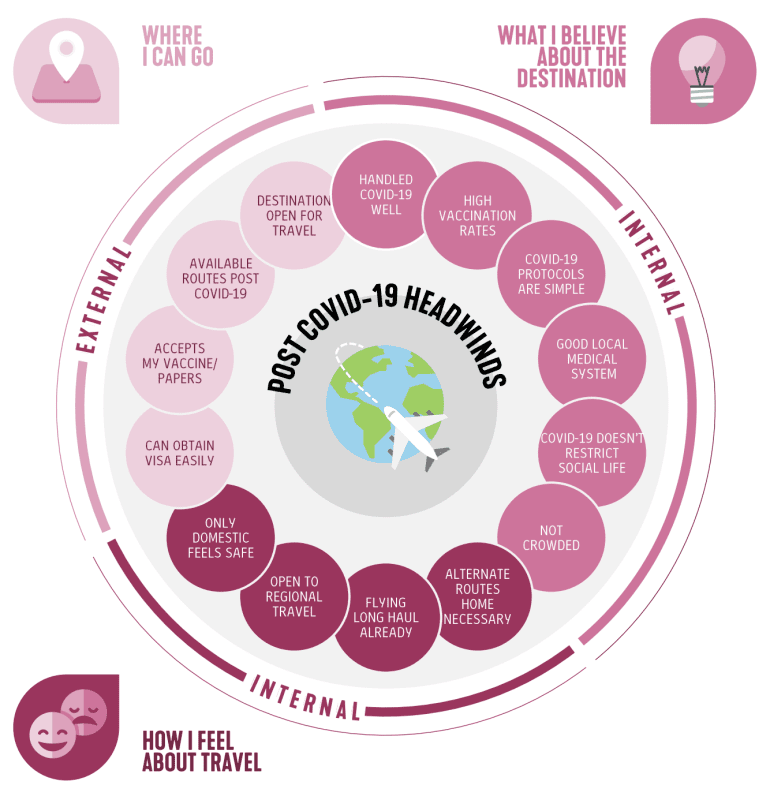
Explosion of Passions and Hobbies driving new demand
The other great insight shared was the impact of COVID on hobbies and passions – and the increased depth and breadth of passions points that people will travel to destinations for (case in point… I recently went to an Autumn Garden Festival in my region, which I probably wouldn’t have gone to pre-covid thanks to my new interest in gardening!).
This data could potentially be game changing for destinations, as they look to ramp up their strategic events calendar, and also helpful for DMOs as they advise business owners on creating new or enhancing current ‘passion’ experiences.
‘Traveller Typologies’ help to sort wheat from chaff
This research uncovered a deeper layer of detail to help us to better understand the traveller ‘needs’ and how that affects key travel decisions such as destination, style of travel and activities or experiences engaged in.
Seven traveller typologies are referenced throughout the Report to help unlock the ‘why’ behind travel choices, and the demand for those choices which can help destinations looking to develop/refine traveller personas to focus their activities and investment.
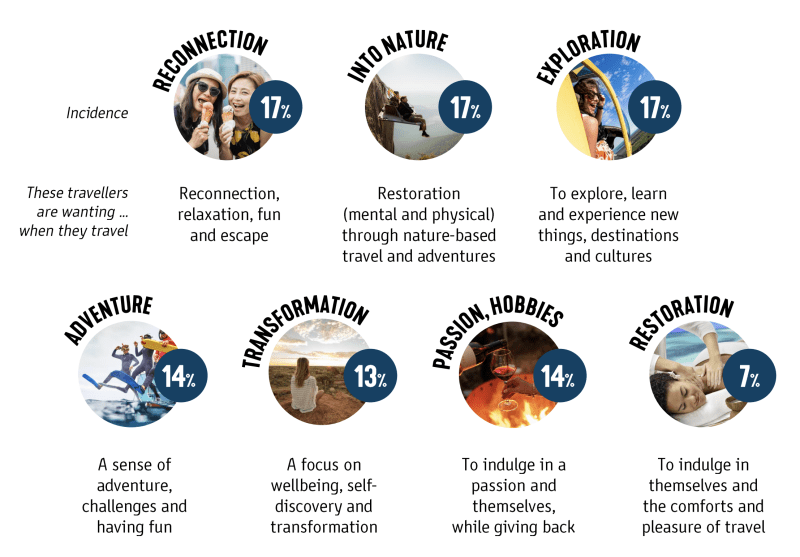
In a fun twist, the data is also broken down into more specific market insights, showing what markets are more relevant for each typology – which can help destinations to better understand the potential market opportunity (specifically for those who are looking to target international visitors).
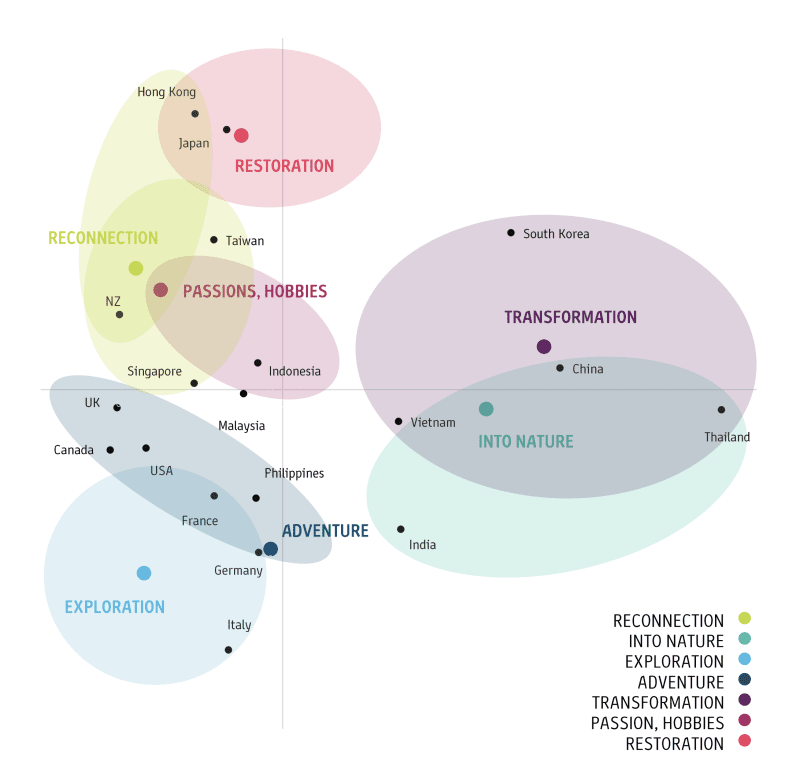
Insight 2: Experience Clusters show how Traveller’s segment our product
The next section of the data does a deep dive into what travellers want out of an Australian holiday experience.
Now this part of the research really takes time to get your head around – but do it, you’ll thank me later!
In what is possibly the most colourful wheel of experiences ever developed, the team at TA have painstakingly grouped experiences into clusters, and sub-clusters based on similarity to each other in terms of consumer appeal.
The data simply tells us how travellers make sense of our experiences, and what experiences then align with others. This is important when you are looking to group and market experiences in your region to effectively increase dispersal of visitation across your region.
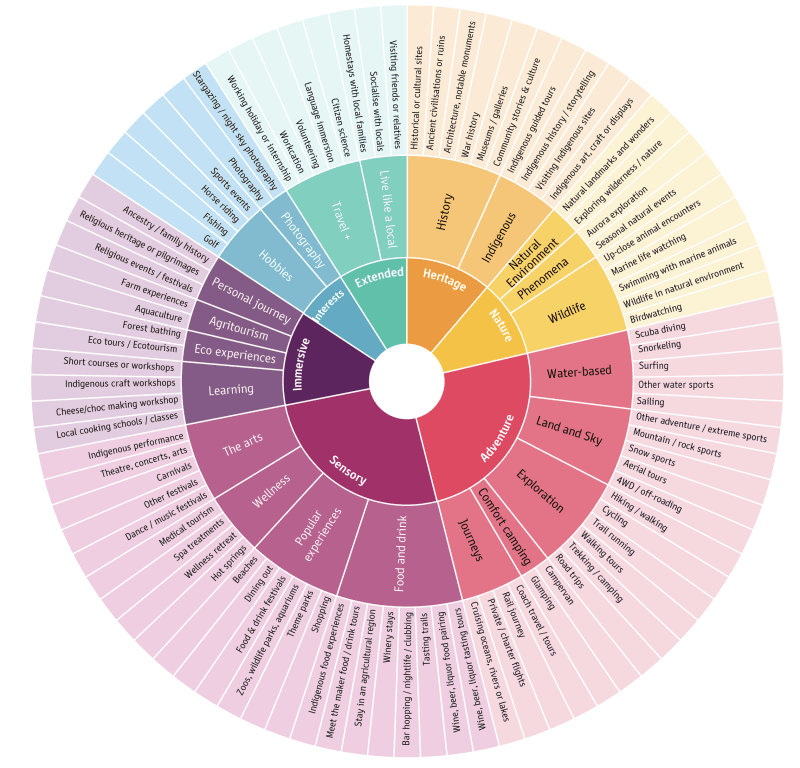
But, further to this, they’ve created some deeper insights for each of the sub-clusters, which provides experience level insights that I’ve never seen before!
These incredible detailed fact sheets have been developed for each Sub-Cluster, which are brilliant to help determine what types of experiences travellers are interested in ‘in addition to’ their current experience.
This information is game-changing!
For Operators, this data can help operators get really clear on:
- The type of traveller (as above) that is most aligned to their experience
- The most relevant market and demographics for their experience
- What other sub-cluster experiences are likely to have appeal (to help with designing new, complimentary experiences, or partnership potential with other organisations)
For Destinations, this granular information can be really helpful in supporting operators to seek out new markets, enhance their current experience, develop new experiences with values-aligned partners and to market their experiences more strategically.
I told you it’s game changing!
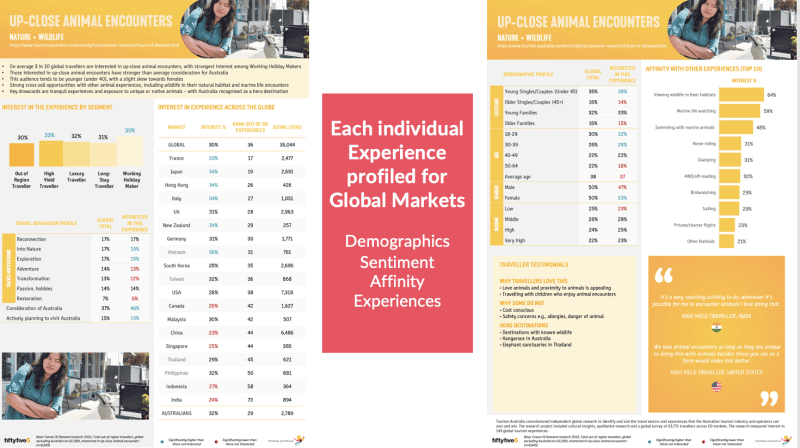
Another layer of interesting data in the report identify’s Australia’s relative strengths and weaknesses in terms of international traveller interest across our experience themes on offer.
As a snapshot, the data highlights:
- We are well known for, and delivering on our promise for our Wildlife, Aquatic and Coastal, Natural Environment, Journey and Hobbies and Leisure experiences
- There is substantial latent demand for our quality Agritourism, Indigenous Tourism, Recreation & Outdoor and Long Stay experiences, however, at the moment there is limited interest in these experiences.
- Whilst there is great interest for Heritage and Food & Drink (this is a particularly large market opportunity) experiences, travellers don’t see these experiences as key strengths
- Wellness, Events and Festivals and Local Culture are almost invisible experience themes for those planning Australian holidays
Destinations can use this data to activate some strategic product development and positioning tactics, including:
- Continue to hero what we’re known and loved for – Wildlife, Aquatic and Coastal, Natural Environment – and advocate for strategic partnerships that highlight other experience themes within these experiences (Indigenous Culture, Agritourism, Recreation & Outdoor)
- Better market our Agritourism, Indigenous, Recreation & Outdoor activities so the latent demand can be activated.
- Support the development of our Wellness, Events & Festivals, Local Culture, Heritage and Food & Drink experience themes, to enhance the quality of these experiences
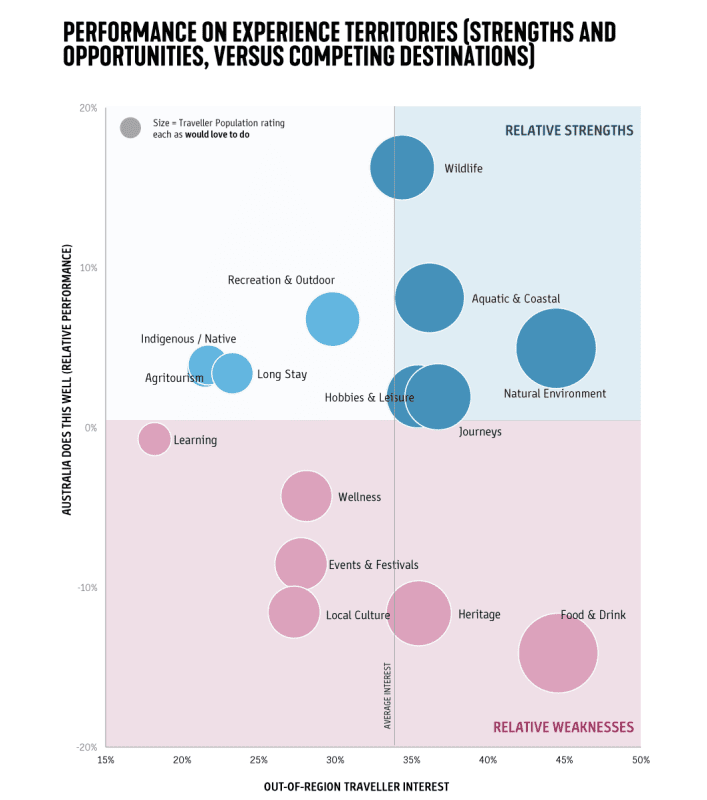
Insight 3: Deep Dive into Accessible, Sustainable & Indigenous Tourism
At the end of this Report, Tourism Australia has also provided some great insights into Sustainable, Accessible and Indigenous Tourism.
Broadly speaking, this information is cross examined with the data above and shares some insights on the demand for these experiences, and also some of the key considerations for DMOs and operators working in this space.
Whilst industry is probably mostly across these themes, there were some gold nuggets throughout the research.
Sustainable Tourism
- There is increasing knowledge about sustainability – moving from well-understood low carbon footprint travel, to practices and experiences that seek to regenerate culture and community.
- Two-Thirds of respondents believe that tourism businesses should engage in many sustainable practices, and will absolutely pay for most/all sustainable experiences – Therefore, proving a business case for the development of active sustainable experiences for the market
- Sustainability-conscious travellers tend to be high yielding and stay longer – Staying in premium accommodation, and they tend to stay an average of 18 nights (as opposed to 13 nights for the less conscious traveller)
- Sustainable practices are not yet driving travel choices – Whilst values can be aligned to sustainable practice within tourism, travelling with sustainable purpose is not yet a primary driver underpinning most travel occasions. Eg. Travellers aren’t seeking end-end sustainable holidays, but they will choose sustainable options along the way in line with their values.
It’s important to remember that sustainable practice is developed from a deeper commitment to a long-term values-driven purpose, as this is what travellers are connecting with, not just a series of sustainability practices put in place (which is now very much a business as usual expectation).
We offer industry capability building opportunities for Sustainable and Regenerative Tourism which may be of interest for destinations seeking support in this area >
Indigenous Tourism
This is the first piece of research I’ve seen about the appeal and potential for Indigenous Tourism (be it mostly from a global perspective), and I found the insights really informative.
The data indicated that Indigenous tourism is viewed with mixed appeal, driven mostly by limited a number of barriers including a limited understanding and concerns of discomfort.
However, when presented with visual cues of what cultural experiences are on offer, and the potential for them being paired with our key brand experience pillars (Nature, Wildlife, Coastal and Agritourism) the appeal and comfort levels increased.
So, I see that there are a few different opportunities here:
- Begin by having thoughtful conversations about opportunities for indigenous tourism with custodians
- Breaking down the barriers through meaningful partnerships and creating a supporting narrative for travellers around what to expect, and how to engage with culture in your region
- Supporting the sensitive development of authentic, ethical and sustainable experiences, where possible, leveraging the themes that are synonymous with the Australian brand that are fun, easy and accessible.
The research indicates that whilst there are many opportunities for Indigenous Tourism, like Sustainable Tourism, it may not be a driver of destination of choice, but is a unique and special enhancement of the overall experience within a region.
Queensland Tourism Industry Council have recently published a helpful resource that can also help guide potential next steps for destinations and operators who are wanting to learn more about Indigenous Tourism.
Accessible Tourism
There is growing awareness of Accessible Tourism across industry, and this piece of data really outlines the market for Accessible tourism, and also that whilst travel intentions are the same with or without accessible needs, the reality normally forces the experience.
The key opportunity I see for operators is to firstly intimately understand the needs of their Ideal Guests. From there, and within the bounds of the experience design, incrementally build on supporting their needs through thoughtful experience design and inclusive communication.
This will be key to supporting this market with more options in your destination, therefore, potentially capturing more of this market that may already have strong appeal for your destination.
ATEC’s Accessible and Inclusive Host Program is a diversity focused business development program with practical learning resources to help you upskill and prepare your business to successfully welcome guests from all life stages, backgrounds and abilities.
How we are using the Insights
Knowing how valid and robust this data is, we are currently using it to support tourism operators through our Industry Mentoring Programs (the photo below is of me delivering these insights in our Hunter Valley ELEVATE Mentoring Program).
We are also using these insights to help inform the strategic planning projects we work on for our clients, including the development of destination plans and strategies.
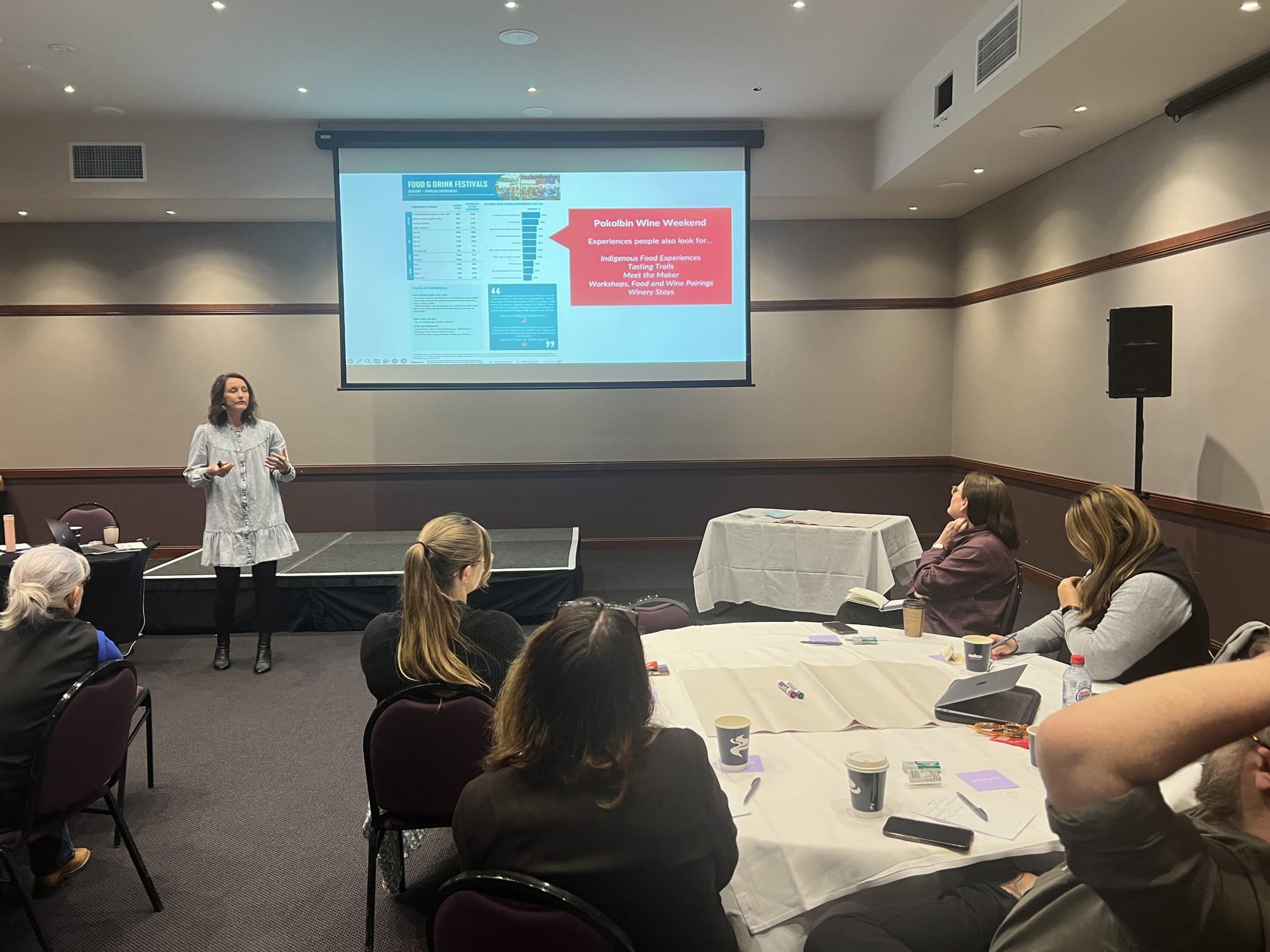
^ Paige presenting insights from the Research Report to operators in our Hunter Valley Tourism Mentoring Program in May 2023.
Read the report for yourself…
Now that you’ve read my summary, it’s time for you to download a copy of the Tourism Australia’s Future of Demand Consumer Research Report for yourself and to put your lens over the insights.
If you have any questions about the research, or would like help interpreting the data for your destination, then the research team at Tourism Australia have shared their email address with us, to share with you – so please do reach out.
Important to Note…
It’s important to note this research project highlights experiences that will drive Australia’s tourism demand from key global markets now and into the future, with a key focus on sustainable, Indigenous, and inclusive tourism.
It will be leveraged by Tourism Australia to guide strategy and provide an information source to assist state and territory tourism organisations, peak bodies, and operators to create experiences and communicate to key markets.
Whilst this is a global study, this research extends beyond Tourism Australia’s core international markets to include emerging markets, as well as the domestic Australian market. (see the graphic below for research methodology)
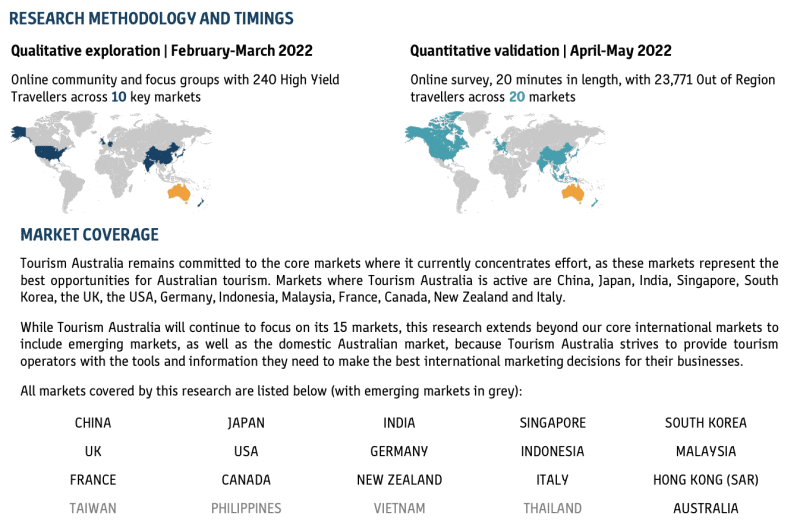
_________________

This article was originally published on The Tourism Collective’s Website > https://tourismcollective.com.au/blog/unpacking-tourism-australias-future-of-global-demand-consumer-research/
More from Tourism Collective’s Learning Hub
- Read more articles on topics relating to Destination Planning > https://tourismcollective.com.au/blog/category/destination/
- Share Tourism Collective’s helpful articles for Tourism Operators in your next Industry Enewsletter > https://tourismcollective.com.au/blog/category/tourism-operators/
Signup to our Enewsletter
Curated insights and inspiration for destination management and marketing organisations: Join our list >
